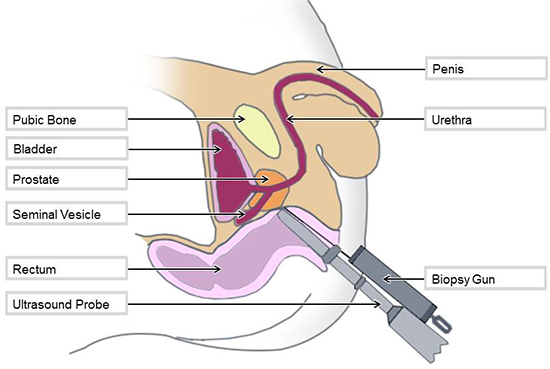Urology |
D11
|
Prostate Cancer investigations
Prostate Cancer Investigations
Transrectal ultrasound guided biopsy of prostate (TRUS biopsy)
Why is this procedure performed?
This procedure is done to look for prostate cancer in patients where concern has been raised because of an abnormal blood test (PSA) or rectal examination. It is also used as part of an active surveillance program in patients already diagnosed with low risk prostate cancer in order to check their disease is not progressing.
What does the procedure involve?
Please attend the TRUS clinic with a full bladder because prior to the biopsy being performed we ask all men to perform a flow test to assess their waterworks followed by a bladder scan to ensure they are emptying their bladder properly.
Diagnosis of prostate cancer requires transrectal ultrasound guided biopsies to be performed. This involves using an ultrasound probe, inserted via the back passage, to scan the prostate. Local anaesthetic is injected around the prostate and between 8 and 12 biopsies are taken with a small needle.
Unfortunately a biopsy can occasionally miss prostate cancer. This means that a negative biopsy (one where no cancer is found) cannot fully exclude the disease. In this case we monitor a patient's PSA over time and repeat biopsies may be needed.

Please let your urologist know if you are taking warfarin or clopidogrel as this will need to be stopped prior to your appointment.
Risks and aftercare
The main risks with this procedure are of bleeding and infection. You will be given an antibiotic prior to the biopsy and will need to continue this for 2 days afterwards. Despite the antibiotic there is still a small risk of developing a serious infection following the biopsy and you should see your GP if you become unwell after the biopsy has been performed. If you develop a fever outside surgery opening hours, you must telephone the emergency number at your GP surgery so that a doctor can assess your condition.
A small amount of bleeding from both the rectum and urethra (water pipe) is normal after a TRUS biopsy. You should drink plenty of fluid in order to keep the urine a light colour. If bleeding is heavy or persistent or you become unable to pass urine at all you need to seek medical advice urgently.
Getting your results
An appointment will be made for you to come back about a week after your biopsies so that one of our Nurse Specialists can give you your results and discus treatment options or arrangements for further follow up.
Saturation biopsies of prostate
In patients who have had negative biopsies but in whom there is still concern about prostate cancer (e.g. strong family history of prostate cancer or a rising PSA blood test) further biopsies are recommended.
Saturation biopsies involve taking 24 biopsies under general anaesthetic in order to improve the chances of finding prostate cancer that is present.
These are usually done as a day case procedure
Template biopsies of the prostate
The RUH is one of only 2 centres in the South West to offer template biopsies of the prostate.
This is a more thorough method of biopsy that is sometimes offered to patients where there is a high level of concern over prostate cancer despite previous negative TRUS biopsies. It is also sometimes used as part of an active surveillance program (see below) in patients already diagnosed with localized, early prostate cancer that do not want active treatment. In this situation it can provide reassurance that the disease is not more aggressive or widespread than originally thought.
What does the procedure involve?
In template biopsies the needles used to sample the prostate are introduced through the perineum (the skin between the scrotum and anus) again under the guidance of a rectal ultrasound probe.
It is performed under general anaesthetic.
It allows more accurate sampling of the prostate especially the bits furthest from the rectum.


